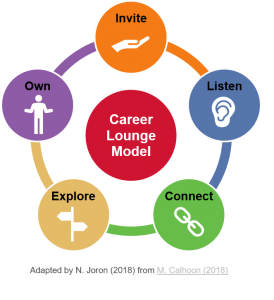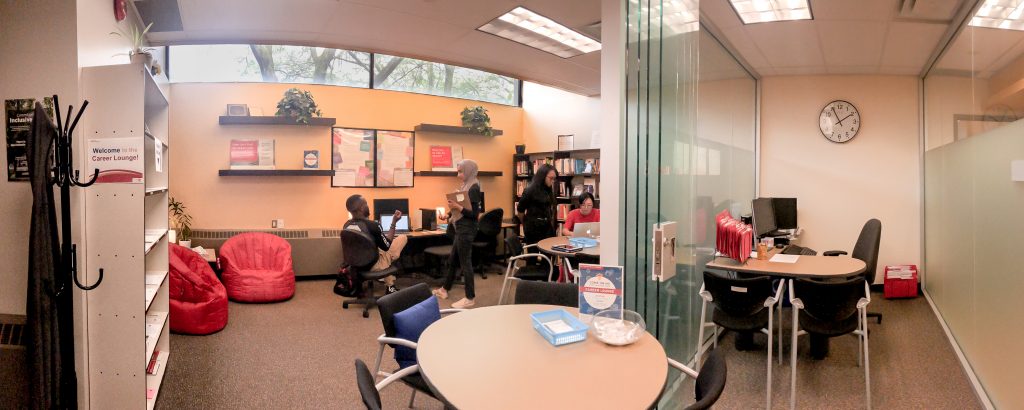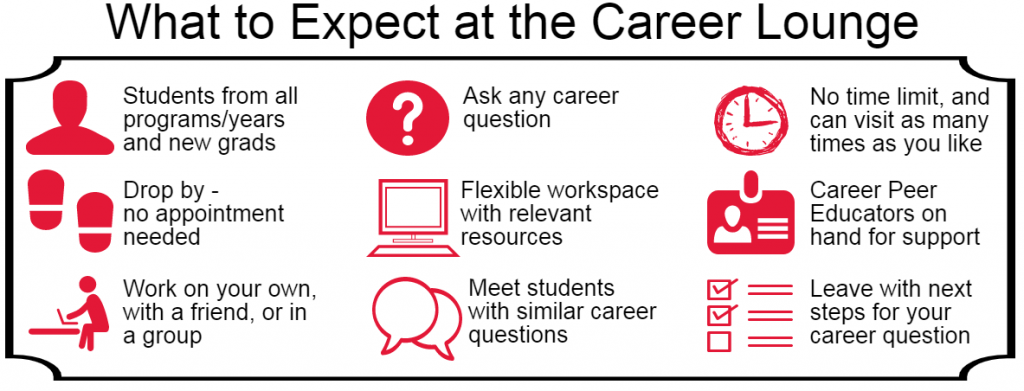I had the pleasure of joining York University’s Career Centre last summer with the exciting task of developing and launching a new career peer-education program. The program is part of a collaborative well-being strategy of peer-led stress-buffering programming across Health Education, Learning Skills, Student Financial Services and the Career Centre. The founding principles of the program were well-being, career self-management, peer education and universal design. After exploring a literature review and environmental scan of existing peer models alongside the needs of the department, we embarked on a mission to create our Career Lounge.
The Career Lounge Model

Adapted from The Studio Method at the University of Nevada, the Career Lounge Model has five components: invite, listen, connect, explore and own. Peers use a coaching approach to implement the model and support students and new grads in developing career self-management skills and confidence. “My role involved guiding students through their career questions and empowering them with the resources to navigate their career journeys,” said Zarlasht Jamal, Career Peer Educator and third-year Global Health student.
Career Peer Educators learn the model through a week-long training program with a combination of skill-building, career development content and experiential activities. Peers participate in weekly team meetings throughout the year where they engage in ongoing reflection, discussion and training.
- Invite: Peers welcome students, explain how the Lounge works and invite them to participate, starting with a welcome form.
- Listen: Peers use active-listening techniques to better understand the students’ needs and invite them to set a goal for the session. Peers are encouraged to ask at least three open-ended questions before starting to make connections as the students’ career question may evolve as they share their story.
- Connect: Peers connect students to relevant resources that they can use to build their skills, knowledge and confidence in exploring their career question. Connections are also facilitated between people: peer to peer, peer to student and amongst students.
- Explore: Students explore resources independently, with a peer and/or with other students visiting the Lounge (or a combination thereof). Students exploring similar resources are invited to sit near each other to facilitate co-exploring and making connections. While students are working, peers shares updates so that all peers working that shift know each student by name and what they are working on.
- Own: Peers use coaching conversations to facilitate self-ownership of career decisions throughout the connect and explore stages. As students prepare to leave, peers thank them for spending time with us and invite students to identify one next step they will own for their career journey, to complete a feedback form and to return.

Setting up the Career Lounge
To facilitate the Career Lounge Model, the physical space of the Career Lounge includes multi-format resources (worksheets, books, posters, desktops, iPads), multi-format workspaces (computer stations, round tables, bean bag chairs, a desk), and accents to help create a welcoming environment (coat rack, lamps, plants, pillows, candy bowls). The Lounge atmosphere was created by moving around furniture in an existing front desk space and multi-purposing an advising station. Peers helped to design the Lounge and selected the finishing touches to create an inviting space.
Navigating the Career Lounge Model
What is most unique about the Career Lounge is that it is not a traditional one-on-one appointment, facilitated group session or workshop. It is a new format entirely that I have been calling a “flexible hybrid.”
The Career Lounge Model strives to remove as many barriers as possible; procedures are minimal, and students are involved in co-creating their experience. Visitors have options for how they would like to navigate their time in the Lounge and are invited to make the experience their own. They can choose their preferred type of seating, resource and work style. Furthermore, they can move between options within one visit.
For example, within one visit, a student utilizing the Lounge for resume help may:
- Engage in a one-on-one conversation with a peer
- Explore the resume poster hanging up in the space with another student visiting the Lounge
- Work independently using a resume worksheet (paper or online)
- Work with a partner in the Lounge to compare ideas
- Practice accomplishment statements in a group discussion facilitated by peers
- Work independently to apply what they learned to updating their resume
Throughout, peers rotate around the room to check on students, ask coaching questions, offer encouragement and resources, facilitate conversation amongst visitors and host closing conversations with students as they leave.

Career Lounge pilot results (September 2018 – April 2019)
- Visitors were a mix of undergraduates, graduate students, PhD candidates and recent graduates.
- The number of visitors during a two-to-three-hour shift ranged from one to 18, with two Career Peer Educators.
- 60% of survey respondents were first-time visitors to the Career Centre; they found out about the Lounge from our website or word of mouth (staff, faculty, friend).
- While most visitors stayed for 15-30 minutes, visits ranged from five minutes to three hours
- 90% of survey respondents found the Career Lounge staff and space welcoming, felt that they were referred to appropriate resources and would recommend a friend to visit.
- Career Peer Educators reported building skills in coaching, assertiveness, reflection and career development.
Career Lounge challenges and benefits
The biggest challenge with the Career Lounge has been managing expectations and orienting visitors to the new Career Lounge Model. Peers also struggled at times to feel that they were providing enough support to each student without maintaining one-on-one contact. Secondly, the Career Lounge requires access to resources in the form of dedicated space, materials and staff (ideally two or more peers per shift).
The largest benefit of the Career Lounge was successfully reaching more students, and a new group of students who were not previously accessing the Career Centre. While many new services take time to grow, students were waiting for us to open on day one and keep coming back. The Career Lounge Model also advances just-in time, individualized service provision, shifts service delivery to peers as first point of contact and positively contributes to well-being outcomes.





